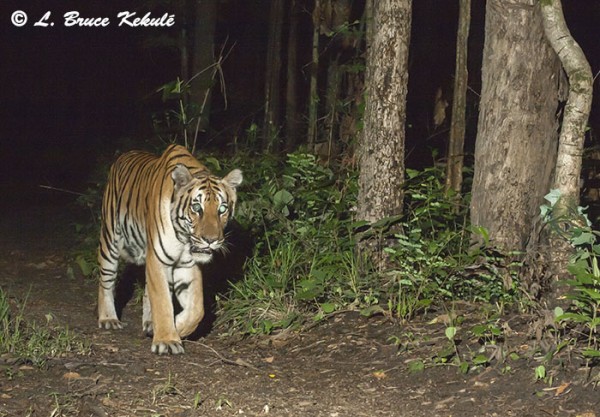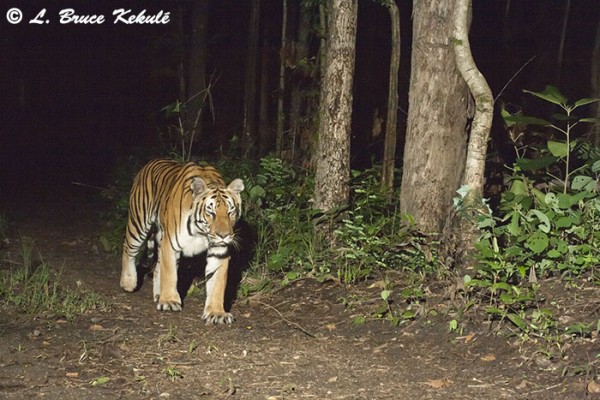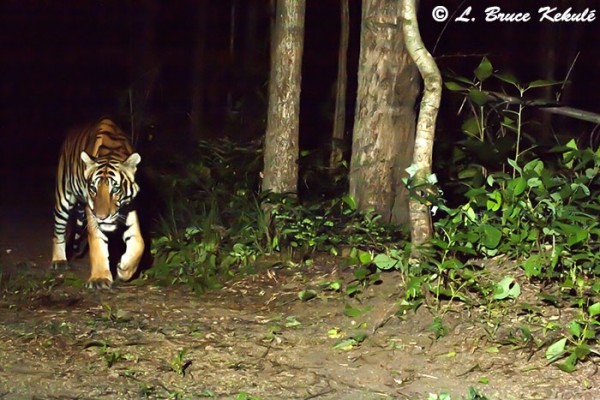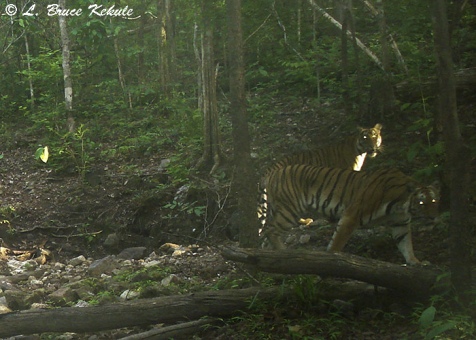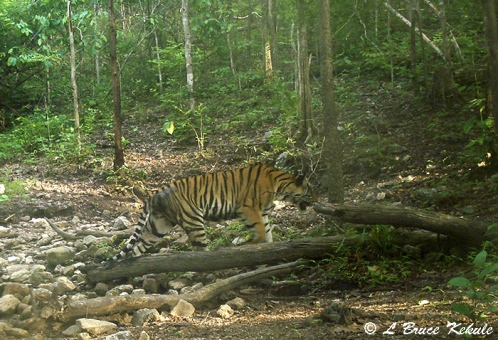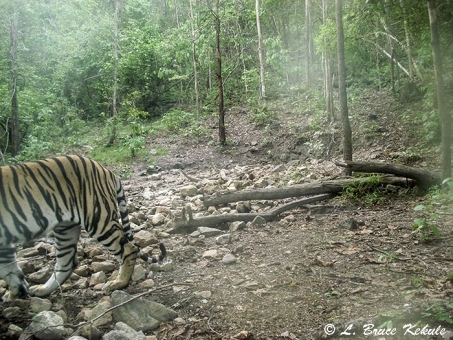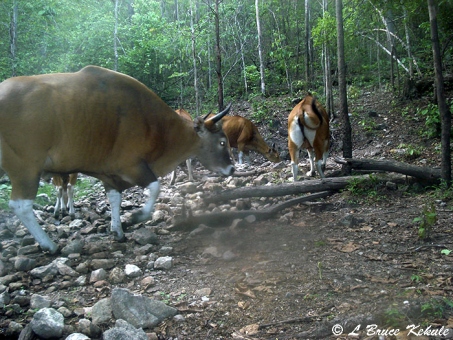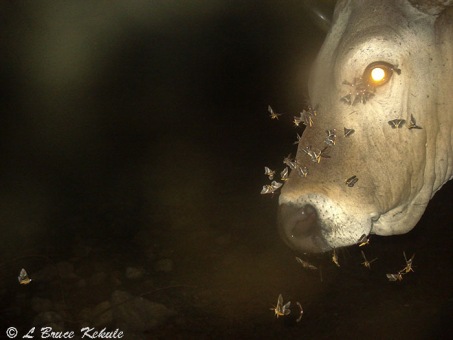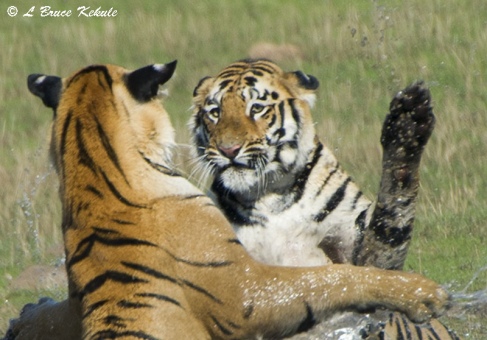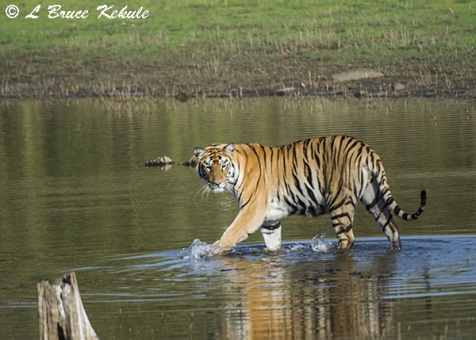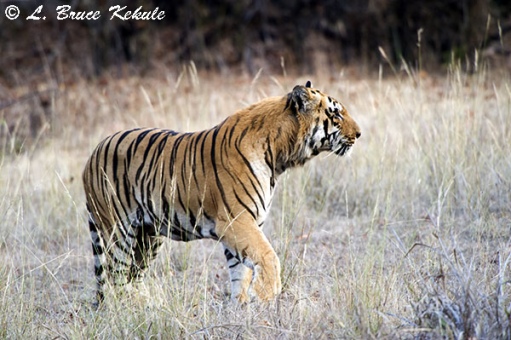Posts Tagged ‘tiger’
Indochinese tiger ‘eye lash’ speed…!
A Canon 400D trail cam catches a male tiger
Old green eyes’…out on a ‘night prowl’…1st shot…!
A couple of days ago, I was checking my cams and got to my Canon 400D on a forest road somewhere in the Western Forest Complex of Thailand. When I got to the cam, it was still working but only one flash three feet above the cam was firing hence the ‘eye-shine’ . The other two flashes were dead…! Life on two Canon Lithium batteries in 30 second power save mode is excellent so I left them just to see how long they would really last….!
Tiger squinting…..2nd shot.
The flash that fired was a SB-26 which I normally set for slave but somehow the settings was on full-power…needless to say, I was delighted and did back-flips when I saw a tiger again, in about the same position as the female back in June in two shots. In both instances, the tigers had their eyes open on the first shot and squinted by the second in almost the same positions. This reaction time is measured in milliseconds…!
Last month’s female tiger…..1st shot.
Then they both jumped out of the frame before the camera could shoot again. This is 100% luck….also shifted the 400D over a tad to the left for better composition. I have included last month’s female tiger shots so a comparison can be made without having to flip back to the old post.
Female squinting…..2nd shot.
All I can say, it boggles the mind but shows how fast tigers can react……Enjoy…!
Canon 400D set to continuous
Nikon 50mm ƒ1.4 manual lens
Nikon SB-26 set to full power.
1/125 – ƒ8 ISO 400.
SSII sensor #6 chip – Pelican 1150
1st shot – cropped and the rest normal size.
Indochinese tigers in Thailand’s Western Forest Complex
Tigers’ reaction to camera traps and red LEDs
The following videos are a collection gathered over the last 6 months of tigers in the Western Forest Complex. Some of these wild cats showed reaction to red LEDs and the cams, but others did not seem bothered. What ever happens with some animals depends on the individual. Needless to say, there are quite a few tigers in this forest. I am trying to improve the quality of the videos with better cams that are in the process of being built…Enjoy…!!
University of Tennessee Wildlife Presentation – November 11, 2013
This is ‘Part One’ titled ‘Chasing a Wild Dream – Predators’ of the presentation I did for the Biology Club at the University of Tennessee on Veteran’s Day, November 11, 2013. There is some old footage but some new including a black leopard in the early morning walking by my cam..one of my favorite videos…..enjoy..!
This is ‘Part Two’ titled ‘Chasing a Wild Dream – Herbivores’. Again, some old and some new….enjoy..!
A Jumping Tiger: Nikon D300s DSLR catches a big cat
The speed and reaction time of an Indochinese tiger is measured in milliseconds….!
The video is a bit raunchy and music is strong but I wanted something else for a change…! This is the most amazing behavior of a tiger I have ever seen.
I set my Nikon D300s DSLR trail cam deep in the forest at a mineral spring where all of Thailand’s large wild mammals like elephant, gaur, banteng, tapir and sambar plus others come for ‘life-giving’ minerals and a drink, and where tigers coming looking for prey.
This cam (set to manual 1/125 – ƒ8 – ISO 400) with a 35mm lens with a Snapshot Sniper SSII sensor fires-off salvos of 8 frames a second every time it records motion. The Nikon D300s was perfect for this location
I was hoping to catch a tiger and thought I might get lucky…but after going through the files, I found 13 photos of a tiger jumping away from the cam. This action footage is my best so far of the tiger in Thailand. The cat is not exceptionally sharp but movement never is and it does not have to be…..!
Amazingly, this male tiger heard the first shutter and reacted in less than three frames and started moving away in what I would like to say, blinding speed…! He looks to be mature judging from his scrotum. This place is truly the last great tiger haven in Thailand and worthy of it’s ‘World Heritage Site’ status…!
All I can say, it’s going to be tough to top this sequence….!
Enjoy…!
TIGER AND BANTENG – Sony W30 set
Tiger mother and two full grown cubs.
Recently, I pulled a Sony W30 camera trap from a mineral deposit in the Western Forest Complex and found some amazing photos of a mother tiger and her two cubs. It is very rare to see a tiger family on a trail cam. These amazing creatures usually do not hang around when it starts flashing at them…but I got some great shots shown here.
Mother and cub.
The two cubs leaving the mineral deposit.
Mother on the way out.
Another tiger visits the camera.
Banteng have now become quite rare in Southeast Asia but thrive in two wildlife sanctuaries in Thailand; one in the east and one in the west. Here are some shots of these beautiful wild cattle. The old bull looks like he is having a heck of time with the moths.
Banteng herd at the mineral deposit.
Old banteng bull and moths after a big rain.
A BIG CAT TRAILHEAD
Tiger Stripes: Identify individual tigers by their stripes and markings
Nature has provided an interesting concept of identifying individuals by certain patterns like tiger stripes, or even human fingerprints for that matter. There are no two individuals alike so one can recognize the same subject in several photographs if the angle is right. I was able to pick-out the same tiger in two photos taken more than a week apart.
Two tiger cubs sparring in the lake at Tadoba.
As most of you know, I recently went to India and photographed some extremely interesting tigers in Tadoba Andhari Tiger Reserve in central India. It was an exciting trip and I got many photographs of the striped predator including jumping tigers in the lake, and close-up roadside portraits plus many more. The cats here pay no attention to the vehicles most of the time and hence, photos are pretty straightforward with the right equipment, right techniques, right timing and some luck I guess.
Tigers sparring up-close.
On the second morning of my safari, a pair of young tiger cubs entered the shallow lake for some fun and cooling off in the morning sun. I had my Nikon D3s and a 200-400mm VRII lens with a 2X converter for 800mm on a monopod and when the action began, I was ready catching the two in mid-air. This shot is probably one of my best ever photographs as a wildlife photographer.
Tiger cub posing by side of the road
Later in the safari near the end, I caught a tiger posing by the side of the road. This female cub is almost mature and about ready to leave the care of her mother and father. She has been roaming by herself more and more recently.
Tiger posing up-close: Note stripe on left cheek.
In the late afternoon on the next to the last day, a whole bunch of jeeps or ‘Gypsies’ as they are called in India were parked waiting on a sleeping tiger. We could not carry-on because the drivers had plugged-up the road so we also parked and waited.
After awhile, a cub got up from her slumber in the bush on the left and crossed the road in front of us. She walked between the cars and an Indian forest official, and then came over to the right side of our jeep and plopped down with her left front paw resting on a rock. I got many photos and some great portraits with loads of behavior and flashing canines.
Imagine my surprise when going through my photos that I was able to distinguish the tiger by the side of the road was the same animal as in the ‘jumping tigers’ shot. After almost a week, this lovely cat came back to bid me farewell and to show me once again, the magnificent beauty of these striped creatures. Also, on how one can recognize individuals by their distinct markings. A perfect ending to the saga of Tadoba Andhari: Land of the Tiger…!
The tigers of Tadoba
India: Land of the tiger
Two tiger cubs sparring in the lake at Tadoba.
After 10 amazing days in the sub-continent of India, I returned to Thailand with a load of tiger photographs. A few shots are some of my best work as a wildlife photographer shown here. The opportunity to see and catch this illusive carnivore presented itself. However, some parts of the trip were extremely dangerous and stressful including a nine-hour taxi ride to and from Tadoba Tiger Reserve in the State of Maharashtra some 700 kilometers north from Hyderabad. It was hectic to say the least.
Only 20% of the sanctuary is now open with 80% off-limits but it is truly India’s top protected area for tiger sightings. I saw nine tigers in seven days. It was very exciting seeing and photographing the big cat. This is just part of the selection of shots I got. It shows a truly magnificent ecosystem where predators thrive because prey species are found in abundance. I will be doing an extensive post a little bit later.
The same pair facing-off.
Tiger cub in the lake.
Tiger male walking by the lake.
Tiger female by the lake.
Tiger cub about three meters away.
Old ‘One Eye’, father of the cubs near the road.
Tiger cub posing by side of the road
Tiger cub about to yawn
Tiger cub showing its fangs
Needless to say, it was an experience now etched in memory. All shots were taken with a Nikon D3s and 200-400mm VRII lens and mono-pod except for the tiger close-up, and that was with a Nikon D90 and a 70-300mm VR lens. I was always ready from close to distant. Enjoy….!
A neelgai (blue bull), a even-toed ungulate found in most Indian protected areas. Prime tiger prey species.
Happy New Year 2013
Photogenic Indochinese tiger
This series of camera trap images of a young tigress was collected in Huai Kha Khaeng Wildlife Sanctuary with a Sony W55 homebrew trail cam during May of this year. This particular tiger does not seem bothered by the flash and I have caught her several times prior to this set. Some animals don’t mind flash while others do. I have a tiger on video growling and back-tracking after seeing the red-LEDs on a Bushnell Trophy Cam. I tend to believe it all depends on the individual animal.
Note the wound on her left flank and ticks in her ears.


